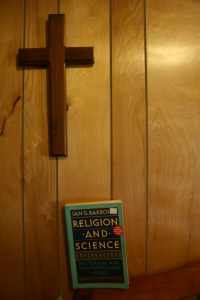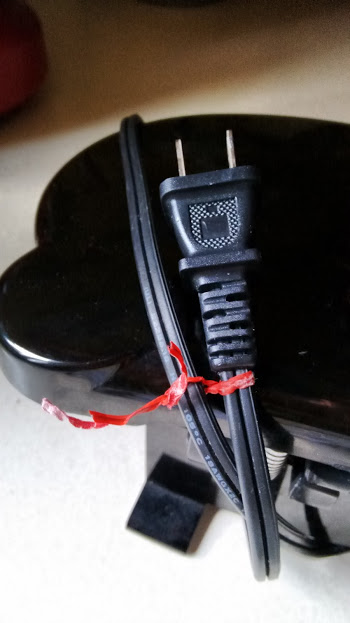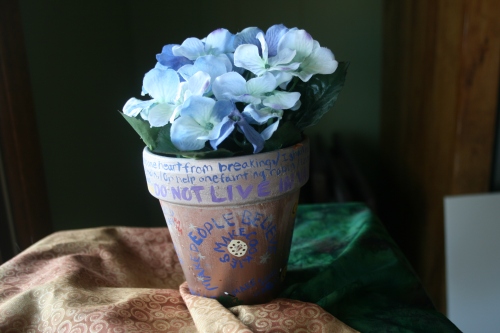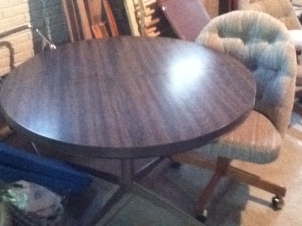I’m sentimental about books. Anyone who knows me knows I love to read. It goes beyond that: I love the feel of a book in my hands, of turning the pages, of getting lost in them. I love to learn. Books carry their own kind of memories, the ones you make in your life while you read them. And Because you read them.

Reconciling my faith with my world.
It was spring (I think) 2001. This was the textbook for my college class by the same name, Religion and Science. It was not an easy read, but it was fascinating. It opened my eyes to so many possibilities about how God could work in the world than I ever imagined. Who knew that the laws of thermodynamics actually left a “space” for God (IMO) when they break down into entropy? I was never one to believe that God cared much about what I ate for breakfast, but those who believe in determinism – that God controls everything – ascribe to this. They find it comforting that their lives are not their own to screw up. I always felt like that was just an easy way to make God the dick for one’s own bad behavior and choices. Or for the rotten chances that occur in life, like car accidents, SIDS, and tripping on a stair and breaking your leg. With determinism, it’s all God’s fault.
On the other hand, I reject the notion that the world was created by chance, and the laws of physics and chemistry control our human nature, because really, isn’t that just another form of determinism? If the laws of nature say that it is natural to cheat on my spouse, should I? Even if God is the one to have set those laws in motion, it’s tough for me to swallow that this great being left us on our own to fend for ourselves? And if you don’t believe in God, well, then that is a different ballpark, one in which humans make and break the rules, so science becomes God.
This book opened me to a new possibility, that chance is built into the system that God created, that chaos is integral to the design. Chaos is where God left himself room to play, to intervene, to push one molecule into a new place and make something else happen. That free will really is free, but God can help choose what outcome comes of it, one of an abundance of choices that follow the laws of physics…or not. God can choose to create miracles at this level and bend physics to do amazing things.
This class was held at 7:45am, an ungodly hour for most college students. It was a lousy time for a discussion class because most students weren’t awake enough to engage. The class was team-taught by a chemist and an Old Testament scholar. The chemist tended to monopolize the lecture a bit and his tangents were hard to follow. The day we discussed this idea of chaos, half the class was asleep and the chemist had droned on for a bit before finally asking a question. I raised my hand and offered my theory that, rather than being scary or contrary to the existence of God, I felt the chance, the chaos, actually brought more “proof” for God, that it gave God a creative place to work in the system, to be the glue that holds the world together from flying apart at the molecular level. The chemist’s face grew grim (he was a determinist) while the OT scholar marched from the back of the room to the front of the room to grin at me. It was a college moment I have always looked back on and cherished because I think I woke the room up, if just a little.

The book that changed how I change books.
It wasn’t just this expanded viewpoint that I got from the book. The book was difficult enough to read and full of interesting ideas, so much so that I broke one of my personal book rules for the first time: I marked it up. Up until that point, I had never highlighted in a book, never underlined, never wrote notes in the margins, never purposely dog-eared a page. With this book, I made it more mine. I still only used pencil, but I underlined and wrote notes and questions to myself. I had finally, at last, recognized that books were not sacred, that they could actually become more by marking in them. Granted, I still tend to treat books with utmost respect, but I’m much more willing to go a different direction than before.
I’ve kept the book for over ten years, always thinking that I would someday revisit those moments, those passages that opened my eyes to something new. I finally recognize that there are too many other books out there yearning to do the same thing. I’ve donated the book, along with several others, to my local friends of the library for their book sale. Perhaps it can do for someone else what it did for me.
Read Full Post »











